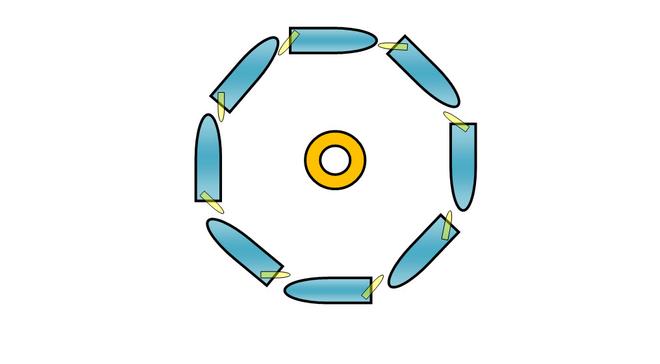Master the Magic of Your Boat's 'Pivot Point'
by John Jamieson on 27 Sep 2013

Natural Pivot Point - Use your sailboat's "natural" pivot point location to make a turn around a piling, approach a pier, avoid contact with another boat. An exception would be if you attempt to recover a person or object from the water; see below for more details. Captain John Jamieson
Imagine one magic point located along the side of your sailboat that could help you make maneuvering decisions with more precision. Need to pivot your boat around a piling, approach a pier or seawall with pinpoint accuracy, turn your boat 'on a dime' into a tight boat slip, or maneuver in an instant to avoid collision with a million dollar yacht?
Use Your Sailboat's 'Natural' Pivot Point :
All boats and ships, no matter their size, have a spot along each side called a 'pivot point'. I like to refer to this as the vessel's 'natural' pivot point. No matter what your speed, or the conditions of wind or current, this natural pivot point will remain in the same place.
Use your boat's natural pivot point to:
* Approach a pier or seawall with accuracy.
* Time your turn into a tight boat slip.
* Turn your boat to enter a narrow channel.
* Avoid a collision with another boat or object.
* Plan recovery for a person or object overboard.
Think of the natural pivot point as an imaginary point near the beam of your boat. In forward propulsion, pivot point will shift a bit toward the bow. In reverse propulsion, pivot point shifts a bit toward the stern. Your boat will pivot around this point when you turn the wheel or push the tiller over to one side.
Note in the illustration how we make a starboard turn around a life-ring in the water. We hold the wheel hard to starboard (or push the tiller hard to port) and shift into forward propulsion. Project an imaginary line from a point near the beam to the life-ring.
Look at each position around the turning-circle and you will see how the natural pivot point never changes. Anywhere along the circle, you can still project a line from near the beam of the boat to the object off the beam. Use this secret in boat handling to turn your boat around a piling, avoid contact with another boat, or line up for an approach to a pier or slip.
Also, remember this little-known fact about pivot point in an overboard sailing emergency. Look at the illustration and imagine that was a person in the water in the center of the circle. Notice how the boat would make a continuous loop around the person. If the person was conscious and uninjured and could assist in the recovery, this may be advantageous (i.e. the Life-Sling method or a similar approach).
But...
If the person in the water was unconscious or injured and unable to assist in the recovery, you would need to fall off and make another approach. Keep the person forward of the beam on the approach and out of the pivot-point area. That way, you will be able to bring the boat closer to them for recovery.
Create Your Own 'Artificial' Pivot Point:
When docking alongside a pier or seawall you will use spring lines. As you learned, springs are attached to a specific point along the side of your boat. When you do this, you create an 'artificial' pivot point. The artificial pivot point will override your boat's natural pivot point. This puts you in total control of the docking maneuver!
Use an artificial pivot point to:
* Work your boat into a narrow space between two boats.
* Dock your boat with precision in wind or current.
* Un-dock your boat with complete control.
* Slide your boat smooth and easy in or out of a slip.
* Control your boat in heavy weather inside a narrow marina.
In the illustration, you have decided to make the port bow cleat the 'artificial' pivot point. As soon as you belay the spring line to a shore side piling and have your bow resting against the pier (with proper fenders in place), turn your wheel hard to starboard (or hold the tiller hard to port).
Next, you shift your engine into forward propulsion at the slowest speed possible. This places a strain onto the spring line (in this case an after bow spring). Note how the boat pivots around the artificial pivot point (boat cleat).
The bow pivots to the right, which brings the stern flush alongside the pier smooth and easy (see Chapter 8 to learn more about docking or un-docking your boat in wind and current).
Now you know how the pros use the dynamic-duo of natural and artificial pivot points to dock, undock, and maneuver your boat with confidence. Put these docking tips into practice aboard your sailing boat and in no time, you will be 'wowing' your friends with your smooth and effortless boat handling abilities--wherever in the world you choose to sail!
~~~~~~~~~~~~~~~~~~~~
John Jamieson (Captain John) with 25+ years of experience shows you the no-nonsense cruising skills you need for safer sailing worldwide. Visit his website at www.skippertips.com. Sign up for the Free, highly popular weekly 'Captain John's Sailing Tip-of-the-Week'. Discover how you can gain instant access to hundreds of sailing articles, videos, and e-Books!
If you want to link to this article then please use this URL: www.sailworldcruising.com/115060